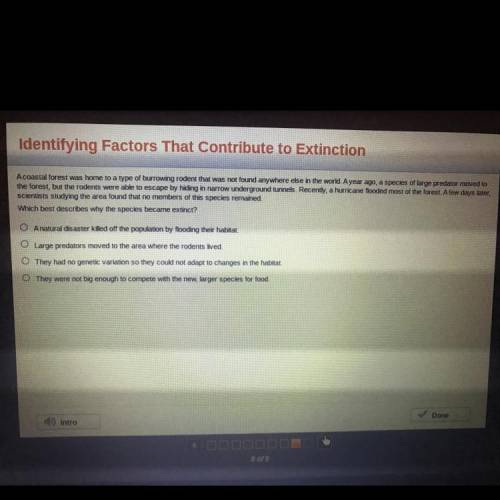
Biology, 28.10.2020 01:40, alyxkellar06
Acoastal forest was home to a type of burrowing rodent that was not found anywhere else in the world. A year ago, a species of large predator moved to
the forest, but the rodents were able to escape by hiding in narrow underground tunnels. Recently, a hurricane flooded most of the forest. A few days later,
scientists studying the area found that no members of this species remained
Which best describes why the species became extinct?
O A natural disaster killed off the population by flooding their habitat.
Large predators moved to the area where the rodents lived,
They had no genetic variation so they could not adapt to changes in the habitat
They were not big enough to compete with the new larger species for food,
Moo


Answers: 1
Other questions on the subject: Biology

Biology, 21.06.2019 23:00, alishajade
Explain how ancient whale fossils found in eqypt are believed to support the theory of evolution.
Answers: 1

Biology, 22.06.2019 04:00, zegangke1651
Will mark brainliest i only need the ! 1.use ten beads and a centromere of one color to construct the long chromosome. use ten beads and a centromere of a second color to construct the second chromosome in the long pair. make a drawing of the chromosomes in the space below. 2. for the second pair of chromosomes, use only five beads. 3. now model the replication of the chromosomes. make a drawing of your model in the space below. part b: meiosis i during meiosis i, the cell divides into two diploid daughter cells. 4. pair up the chromosomes to form tetrads. use the longer tetrad to model crossing-over. make a drawing of the tetrads in the space below. 5. line up the tetrads across the center of your “cell.” then model what happens to the chromosomes during anaphase i. 6. divide the cell into two daughter cells. use the space below to make a drawing of the result. part c: meiosis ii during meiosis ii, the daughter cells divide again. 7. line up the chromosomes at the center of the first cell, one above the other. separate the chromatids in each chromosome and move them to opposite sides of the cell. 8. repeat step 7 for the second cell. 9. divide each cell into two daughter cells. use the space below to make a drawing of the four haploid cells
Answers: 1

Biology, 22.06.2019 12:30, justijust500
Consider the equation s + o2 ? so2. what is the product? question 3 options: s so 2 s + so 2 o 2
Answers: 3

Biology, 22.06.2019 18:30, eloqit3346
The hypothesis that evolution occurs at an irregular rate through geologic time is known as: directional evolution directional equilibrium punctuated equilibrium punctuated evolution
Answers: 1
Do you know the correct answer?
Acoastal forest was home to a type of burrowing rodent that was not found anywhere else in the world...
Questions in other subjects:

Spanish, 11.11.2020 02:40

Biology, 11.11.2020 02:40

Biology, 11.11.2020 02:40

Mathematics, 11.11.2020 02:40

History, 11.11.2020 02:40


Mathematics, 11.11.2020 02:40

Arts, 11.11.2020 02:40







